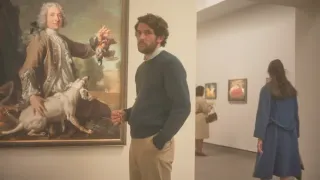
Oct 5
Destin Conrad Brings Queer Joy and Authenticity to R&B With "Love On Digital"
READ TIME: 4 MIN.
Destin Conrad, the Los Angeles-based singer-songwriter, is rapidly ascending the ranks of R&B with a sound defined by honesty, versatility, and a steadfast commitment to representation. In a new feature published by BET, Conrad discusses his journey from church choirs to the main stage, his new project "Love on Digital," and the importance of centering queer love in his work—a stance that is resonating deeply across the LGBTQ+ community and the broader music landscape .
Conrad’s early years were shaped by music in the church, but he quickly found that the songs he created with his long-time collaborator and producer, Louie, were too personal to give away. “What began as demos with my producer, Louie, evolved into something too personal to hand off. I made my first EP with my producer, Louie. We started making demos, but they felt too personal to give to other people,” Conrad told BET, underscoring how intimacy and vulnerability became the foundation of his artistry .
His trajectory was anything but conventional. Before launching his solo music, Conrad first gained attention as a songwriter, only to realize that his truest expression came from performing his own material. This transition was not just professional but deeply personal, allowing him to step fully into an identity that was both musically and emotionally authentic .
A defining characteristic of Conrad’s work is his open embrace of queer love and relationships—a rarity in mainstream R&B. He frequently references love between men with pronouns like “he” and “him,” an intentional act of visibility that he views as non-negotiable. "It makes me so happy when other queer people feel seen by me or feel like they have my voice as a reference," Conrad said in the BET interview, noting that writing from a place of truth is central to his music .
Such representation is significant not only for queer audiences who have long felt underrepresented in R&B, but also for the genre itself, which has traditionally centered heteronormative narratives. Conrad’s approach is part of a broader movement among contemporary Black artists who are redefining mainstream genres on their own terms and pushing for greater inclusivity and honesty .
Conrad’s latest album, "Love on Digital," marks a turning point, both sonically and thematically. The project leans into nostalgia and live performance energy, offering a collection of tracks that are as introspective as they are optimistic. “I wanted to channel that nostalgia. I wasn’t trying to do anything out of the box, just something that felt like something I’d heard before,” he explained to BET .
Despite the occasional vulnerability, Conrad insists that the album is ultimately about fun. “I don’t want people to think too deep into it because I didn’t think too deep into making it,” he said. “Optimism, divine optimism, and joy,” are the takeaways he hopes listeners will leave with—a message that resonates with LGBTQ+ audiences seeking both representation and joy in their cultural touchstones .
Conrad’s recent partnership with D’USSÉ for a celebratory dinner in Brooklyn ahead of his "Love on Digital" tour illustrates his commitment to building community. The event, which doubled as a send-off with friends, was described by Conrad as a moment where he “felt really loved,” highlighting the importance of queer joy and chosen family in his journey .
This ethos of community extends to his live performances and public appearances. At recent events like CultureCon 2025, Conrad was recognized as one of several artists redefining pop and R&B by centering authenticity and unapologetic self-expression .
For Conrad, music is an act of truth-telling—a principle that carries particular weight for LGBTQ+ artists in mainstream genres. "All I can do is write from the truth. I would hate to make music and lie," he explained, articulating a philosophy that prioritizes both artistic integrity and the lived experiences of queer people .
His willingness to be vulnerable and open has not gone unnoticed. Conrad’s interview on The Cruz Show, for example, highlighted how his creative evolution is tied to personal growth and the support of fellow artists like Kehlani, who surprised him during the interview with a call of encouragement .
Conrad’s visibility and success are part of a growing shift within R&B and pop, as more Black queer artists claim space and reshape the mainstream narrative. Events like CultureCon, which celebrate the intersection of Black excellence, creativity, and LGBTQ+ pride, further amplify these voices and provide platforms for artists breaking new ground .
The impact is tangible: younger audiences and aspiring musicians are seeing themselves reflected in ways that were once rare in R&B. Conrad’s music and public presence offer not just entertainment, but affirmation and a blueprint for living authentically.
As "Love on Digital" continues to make waves, Conrad’s message is clear: joy, optimism, and self-acceptance are at the heart of both his music and his mission. In a cultural climate where LGBTQ+ visibility remains critical, Conrad’s work stands as a beacon for those seeking both representation and inspiration.
From the pulpit of his childhood church to the stages of New York and beyond, Destin Conrad is proving that the future of R&B is not only inclusive, but also vibrant, joyful, and unapologetically queer .






